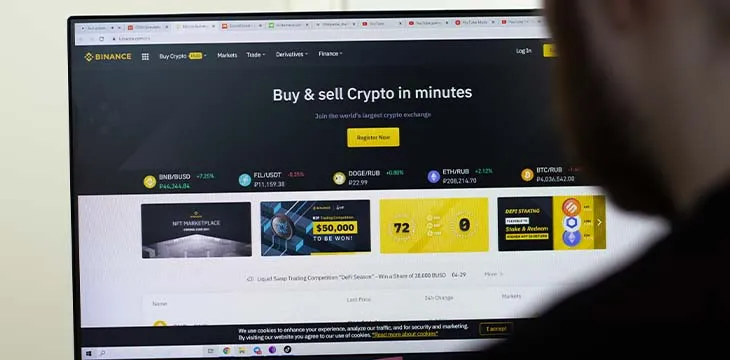|
Getting your Trinity Audio player ready...
|
Binance continues to make a big show of seeking regulatory approval while treating its customers as if there are no consequences for its sketchy behavior.
In the least surprising news to emerge from Monday’s ‘crypto’ crash, the Binance exchange temporarily froze all BTC withdrawals from its platform. Apparently, the exchange bosses were seeking to eliminate all distractions in order to fully concentrate on front-running their rank-and-file customers and liquidating leveraged traders who found themselves with no means of revising their positions.
While Binance going offline during a crypto crash is by now almost comically routine, Monday’s outage was accompanied by the truly hilarious explanation from Binance boss Changpeng ‘CZ’ Zhao that there was “a stuck transaction causing a backlog.” CZ helpfully explained that the problem “should be fixed in ~30 minutes,” although the actual delay turned out to be more like three hours.
CZ’s ‘stuck transaction’ line conjures up images of Binance staffers racing up and down the corridors of their non-existent offices looking for whoever had the transaction plunger so they could swiftly dislodge this reluctant crypturd. And let this be the final word to those of you who long ago mocked U.S. Senator Ted Stevens for declaring that the internet was “a series of tubes.” Sometimes the old guy yelling at clouds knows what he’s talking about.
Oddly enough, the Coinbase exchange (NASDAQ: COIN) endured a similar clogging, leading countless customers to take to Twitter to vent their frustrations at their inability to access their accounts when they most needed to. The crisis of confidence also hit Coinbase shareholders, who pushed the stock down nearly 11.5% by Monday’s close to $52.01, around 1/7th of the company’s 52-week high.
The carnage was even more acute over at MicroStrategy, which fell more than one-quarter to $152.15 by Monday’s close and continued to fall in after-hours trading. The erstwhile business analytics software outfit cum pseudo-BTC ETF is the single largest corporate holder of BTC but its investment is down a whopping ONE BILLION DOLLARS at present and a painful margin call awaits if BTC continues its downward trajectory. But hey, this is the perfect opportunity for Michael Saylor to sell whatever other assets he owns to buy the dip.
Binance v the world
Meanwhile, Binance is continuing its quest to acquire regulatory permission to operate in markets in which it has little or no physical presence, presumably because establishing a physical office might allow the authorities some means of retaliation the next time the cryptocurrency exchange is caught abusing its customers to feather its own nest.
Last week, CZ confirmed rumors that Binance was looking to acquire Virtual Asset Service Provider (VASP) and Electronic Money Issuer (EMI) licenses in the Philippines. CZ made the comments during a media briefing in which he discussed meeting with Philippine officials about updating regulations to address digital currency-related activities.
CZ had no hard timelines for when local regulatory approval might be forthcoming, saying only he expects good news ‘within months.’ In March, Binance was already looking for a Philippines country director, someone expressly willing to “get their hands dirty.” It will be up to this as-yet-unidentified director to “relentlessly push operational standards” while making nice with local regulators.
That may prove harder than CZ would prefer, as following his media briefing Philippine Finance Secretary Carlos Dominguez III found it necessary to issue a statement reminding the nation that Binance “is not registered with us as a company but we are tracing them thru [sic] our system.”
LOOK: Finance Secretary Carlos Dominguez III reminds Filipinos that crypto giant Binance has no records with the Securities and Exchange Commission. Binance faces investigation in the US for reportedly serving as a conduit for money laundering | @alyasjah pic.twitter.com/LogLRFGr1S
— The Philippine Star (@PhilippineStar) June 9, 2022
Binance is notorious for making a high-profile show of seeking local licenses but as time goes by and regulators get fed up with Binance’s refusal to submit the necessary documentation, Binance eventually walks away from the table. Binance apparently believes that the positive press from its initial high-minded declarations will linger online and thus continue to push Binance’s preferred image of a law-abiding, regulatory-compliant entity.
Taken for a ride
CZ’s ability to manipulate the media was on full display when he chose to ride the Binance-branded Jeepney that has been traversing Manila’s streets for a while now. The vehicle travels a 15- to 20-minute route around Bonifacio Global City in Taguig, enough time for Binance reps to promote numerous aspects of their operation to unsuspecting passengers.
Among the topics being pushed are enrolling in the Binance Academy, which aims to educate neophytes on how crypto works. There’s also tips on how to join the Binance Angels, the unpaid army of online influencers eager to hype the exchange to would-be ‘crypto’ suckers, er, investors. And hey, if you really don’t like your friends all that much, you can earn rewards through Binance’s referral program by being the Judas Goat that leads them to the slaughter.
Of course, if Binance’s Jeepney rides truly reflected what exchange customers can expect during ‘crypto’ crashes, passengers would find themselves involuntarily strapped into their seats, unable to get off at their chosen destination and forced to ride for hours until being unceremoniously dumped on the side of the road without enough money to get home.
Since Binance’s main function is collecting commissions on speculative shitcoin flipping from which few individuals will actually come out ahead, its decision to target the lower socioeconomic strata that patronize Jeepneys seems needlessly predatory. A jeepney ride is about .15 cents. Binance’s timing appears equally tone deaf, given that lower-income Filipinos were the largest demographic participating in the ‘play-to-earn’ Axie Infinity game before a hack wrecked its questionable economic model.
Binance wasn’t the first digital asset firm to use Jeepneys to get its message out. But instead of promoting a speculative crypto casino, this earlier Jeepney was about demonstrating that a blockchain with unbounded scaling capacity could enable cost-effective small transactions—like the fares that Jeepney passengers have traditionally paid—without imposing fees that are larger than the cost of the ride.
In other words, one was a project that looked to improve the lives of those on the economic ladder’s lower rungs, while the other was an entity selling false dreams of instant wealth that will ultimately leave these individuals poorer than when they started. The Philippines would be well advised to keep its citizens safe by keeping Binance off its streets.
Follow CoinGeek’s Crypto Crime Cartel series, which delves into the stream of groups from BitMEX to Binance, Bitcoin.com, Blockstream, ShapeShift, Coinbase, Ripple,
Ethereum, FTX and Tether—who have co-opted the digital asset revolution and turned the industry into a minefield for naïve (and even experienced) players in the market.

 05-08-2025
05-08-2025 





